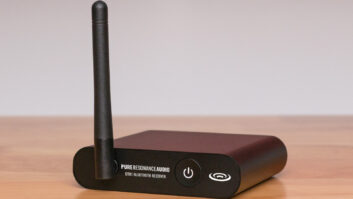It’s clear that music distribution is increasingly about downloads and streaming (iTunes is the top US music retailer), which is certainly convenient—with a decent internet connection you can listen to and/or buy pretty much anything, at any time. But the price of this convenience is the data compression that allows music to squeeze through our existing internet pipes. Whether MP3, AAC, WMA, etc., what comes out is not what goes in. (Lossless compression protocols like FLAC do reproduce the original audio when decoded, but file size savings aren’t as significant.)

So there’s a movement to improve the quality of the audio that reaches the consumer, like Apple’s “Mastered for iTunes” initiative. iTunes started out a decade ago offering AAC files at 128 kbps. The catalog has since been upgraded to 256 kbps, but more importantly, uses Variable Bit Rate encoding to adapt to music that requires more or less detail. The result is better fidelity than expected from a given file size.
Even more significantly, Apple solicits 24-bit/96 kHz files for encoding. People can debate whether that ultimately makes a difference in quality, but if Apple wants to upgrade to a higher-quality format in the future, they’ll have the necessary source material. Apple also provides tools that allow engineers to take the final delivery file’s sound into account when mastering. As an analogy, this is somewhat like mixing with a limiter in the mix bus (which is removed prior to exporting) to “estimate” how any limiting used in the mastering process will affect the mix.
There’s also been some buzz about Neil Young’s “Pono” system, which when introduced sometime next year will supposedly deliver higher quality audio (i.e., higher bit depths and sampling rates). As to the present, Sony recently introduced its ES (Elevated Standard) line of high-resolution audio devices. The heart is a DSD remastering engine that converts audio to a 5.6 MHz DSD stream. Although it’s easy to argue that the source material is the limiting factor, just as better speakers will make source material sound better, so do high-quality elements used in audio reproduction. Sony couples the conversion process with what’s claimed to be a super-high quality signal path as well as its Digital Sound Enhancement Engine (DSEE), whose noise-shaping technology provides some degree of signal restoration.
Interestingly, Sony’s UDA-1 is designed specifically for computer-based listening experiences and employs an asynchronous USB connection. It’s compatible with not only iTunes and Windows Media Player, but also Korg’s Audio Gate. Sony has even introduced speakers and headphones designed specifically for the line of ES components.
Perhaps the ultimate irony is that digital downloads, which started the race to the bottom, make a climb to the top more likely because even though there’s no standardized consumer playback medium for 24-bit files, computer-based media players can handle them. Nine Inch Nails offered The Slip as a 24-bit/96 kHz WAV file back in 2008, and the group’s latest album, Hesitation Marks, is downloadable as a 24-bit/48 kHz file as well as in FLAC and data- compressed formats. Sites like iTrax.com, SuperHiRez.com, HDTracks.com and Blue Coast Records also offer downloads in better-than-CD-quality formats.
But the 800-pound gorilla in the room is whether these high-res formats offer a noticeable improvement for the average consumer—let alone whether these “high-res” files make any sense at all if the source material wasn’t created in a correspondingly high-res medium. In my own experience, although I noticed a major difference between 16- and 20-bit digital recording systems, that was back when a 16-bit converter delivered only 12-14 “real” bits due to noise, errors, etc. And there’s no doubt that audio engines need much more than 16- or even 24-bit resolution to avoid rounding errors when mixing music, but that’s not the same thing as using 24 bits for the delivery medium.
I also believe quality material recorded natively as DSD sounds better than PCM, but have doubts about higher PCM sample rates. Some people hear an improvement, while others claim they sound worse because distortion products that don’t exist at lower sample rates end up appearing in the audio range. Furthermore, plenty of tests indicate most people can’t tell the difference between 16- bit/44.1 kHz and 24-bit/96 kHz files. If only a few recording engineers can hear the difference, that doesn’t bode well for mass acceptance.
Yes, we can do better than data-compressed formats. But time will tell whether 16-bit/44.1 kHz is all we need, or whether there’s a consensus that higher-resolution files sound better. Meanwhile, one indisputable fact remains: The easiest route to improved sound quality is upgrading your headphones and speakers.
Craig Anderton has authored more than 30 books on technology and the arts. Check out his latest music videos at youtube.com/thecraiganderton.







